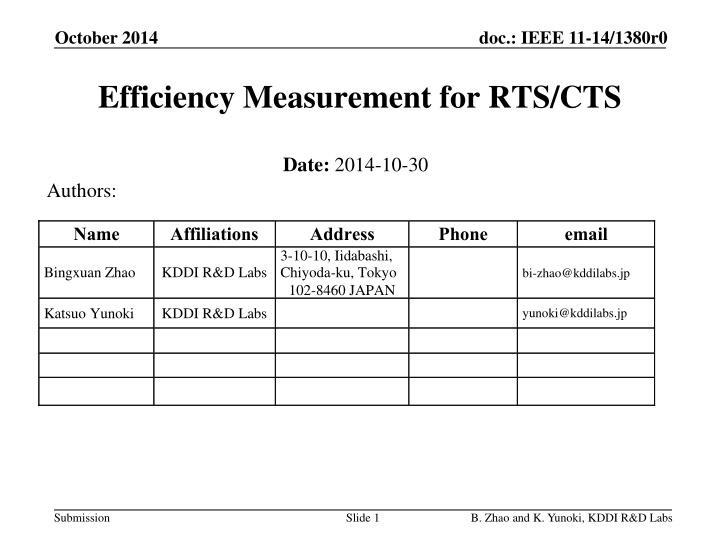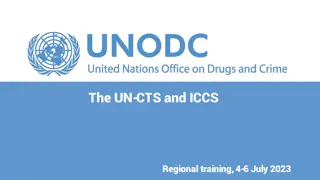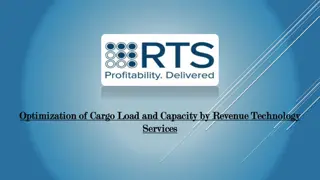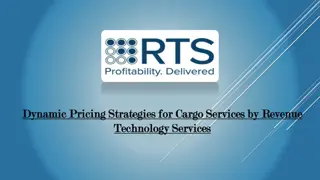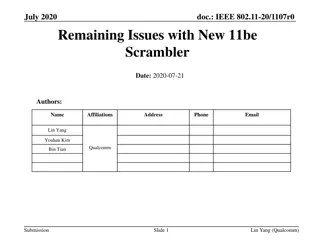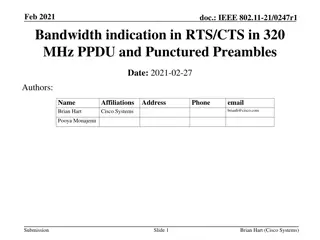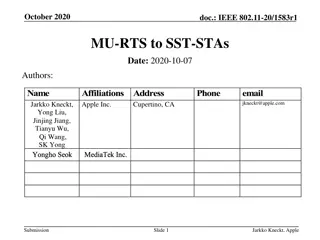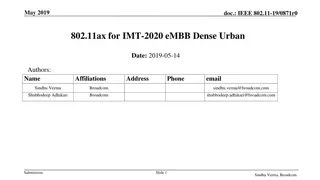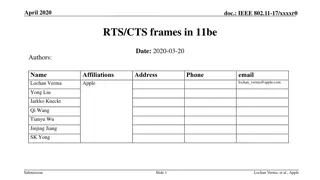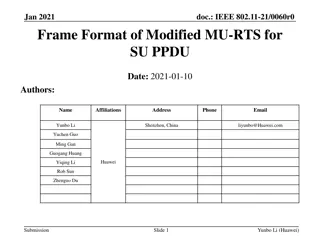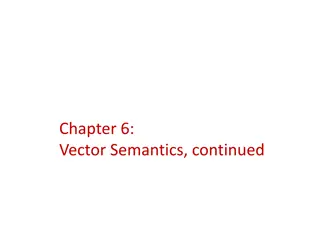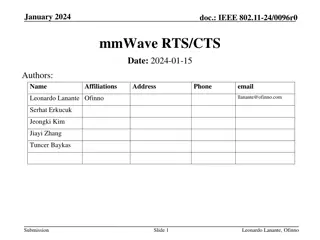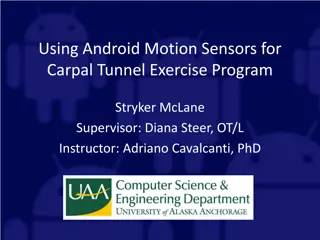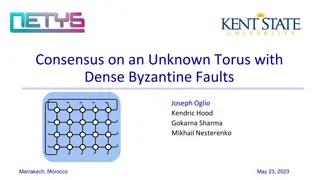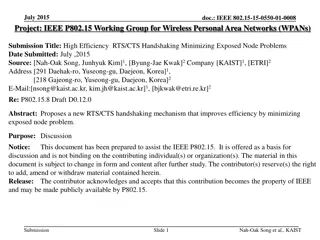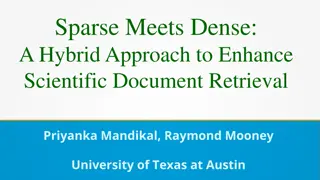Efficiency Measurement for RTS/CTS in Dense Area
This document presents efficiency measurement results for RTS/CTS in a dense area, showcasing higher performance with RTS/CTS compared to without. Throughput, packet retransmission ratio, PHY, MAC, and measured packet retransmission ratios are analyzed in various scenarios.
Download Presentation

Please find below an Image/Link to download the presentation.
The content on the website is provided AS IS for your information and personal use only. It may not be sold, licensed, or shared on other websites without obtaining consent from the author.If you encounter any issues during the download, it is possible that the publisher has removed the file from their server.
You are allowed to download the files provided on this website for personal or commercial use, subject to the condition that they are used lawfully. All files are the property of their respective owners.
The content on the website is provided AS IS for your information and personal use only. It may not be sold, licensed, or shared on other websites without obtaining consent from the author.
E N D
Presentation Transcript
October 2014 doc.: IEEE 11-14/1380r0 Efficiency Measurement for RTS/CTS Date: 2014-10-30 Authors: Name Affiliations Address 3-10-10, Iidabashi, Chiyoda-ku, Tokyo 102-8460 JAPAN Phone email Bingxuan Zhao KDDI R&D Labs bi-zhao@kddilabs.jp Katsuo Yunoki KDDI R&D Labs yunoki@kddilabs.jp Submission Slide 1 B. Zhao and K. Yunoki, KDDI R&D Labs
October 2014 doc.: IEEE 11-14/1380r0 Abstract This document presents the efficiency measurement for RTS/CTS Throughput and packet retransmission ratio were measured by the experiment in the dense area Measure results show that RTS/CTS can achieve slightly higher performance than the case without using RTS/CTS Submission Slide 2 B. Zhao and K. Yunoki, KDDI R&D Labs
October 2014 doc.: IEEE 11-14/1380r0 PHY and MAC to Boost Throughput channel utilization = 95% access efficiency = 30% MAC access efficiency PHY data rate access efficiency = 30% avg data rate = 10Mbps throughput = 3.33Mbps access efficiency = 30% avg data rate = 10Mbps throughput = 3.33Mbps access efficiency = 30% avg data rate = 20Mbps throughput = 6.66Mbps access efficiency = 60% avg data rate = 10Mbps throughput = 6.66Mbps fggg access efficiency = 60% avg data rate = 20Mbps throughput = 13.32Mbps : control/management frames & PHY overhead : successful data : idle channel time : collided data = wasted time Contribution [1] presented that decreasing collided data is a way to boost throughput. We assumed RTS/CTS is one of the possible ways to decrease the packet collision. We performed an experiment to evaluate the efficiency of RTS/CTS in a typical dense area in Tokyo Submission Slide 3 B. Zhao and K. Yunoki, KDDI R&D Labs
October 2014 doc.: IEEE 11-14/1380r0 Measurement Scenario Coffee shop @3rd floor UDP throughput and retry rate were measured with/without RTS & CTS on the street which APs had been densely deployed. AP Frame capture PC UDP packets (1470B) CH100+104 (40MHzBW) ~20m AP @coffee shop ~50m STA ~100m Frames were captured at the AP side. QoS (UDP) QoS (UDP) QoS (UDP) RTS time AP CTS BA time CH100 Many SSIDs were observed on CH100. STA Submission Slide 4 B. Zhao and K. Yunoki, KDDI R&D Labs
October 2014 doc.: IEEE 11-14/1380r0 Measured Packet Retransmission Ratio Tx Power -6dB 26.8% 24.1% 70% 60.5% Full 19.7% 18.4% 47.9% 44.4% 60.9% 50.1% -10dB 40.8% 35.6% Distance RTS/CTS without with without with without with Near (20m) Middle (50m) Not connected Far (100m) Not connected Not connected The value in each case is an average of 30 measurements Due to the protection of RTS/CTS, the packet retransmission ratio is always lower than the case without using RTS/CTS Submission Slide 5 B. Zhao and K. Yunoki, KDDI R&D Labs
October 2014 doc.: IEEE 11-14/1380r0 Measured Throughput (Mbps) Tx Power -6dB 30.7 29.8 3.6 4.5 Full 37.3 36.3 11.6 11.6 6.6 7.0 -10dB 17.6 17.8 Distance RTS/CTS without with without with without with Near (20m) Middle (50m) Not connected Far (100m) Not connected Not connected The value in each case is an average of 30 measurements In weak signal area, RTS/CTS can achieve higher throughput Benefit outweighs overhead Submission Slide 6 B. Zhao and K. Yunoki, KDDI R&D Labs
October 2014 doc.: IEEE 11-14/1380r0 Summary We measured the efficiency of RTS/CTS in a typical dense area in Tokyo Measurement results show that the benefit of RTS/CTS in throughput outweighs the incurred overhead in the weak signal case Submission Slide 7 B. Zhao and K. Yunoki, KDDI R&D Labs
October 2014 doc.: IEEE 11-14/1380r0 Reference 1. 11-14/835r2, Functional Requirements Discursion , Joe Kwak, et al. Submission Slide 8 B. Zhao and K. Yunoki, KDDI R&D Labs
